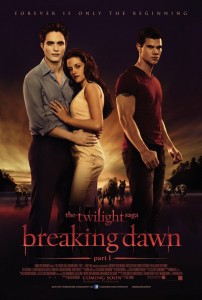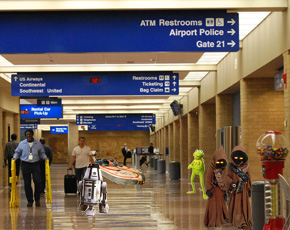 Bum-bum-ba-dum. Bum-bum-ba-dum.
Bum-bum-ba-dum. Bum-bum-ba-dum.
Bella (Kristen Stewart) is finally marrying sparkly vamp Edward (Robert Pattinson). They whisk away on their honeymoon to a private island getaway home where Bella has decided to hold off on her ‘undead’ transformation and enjoy a few more weeks as a human. Does this make much sense? Jacob (Taylor Lautner) seems to think not. He believes Edward will be too powerful and could possibly kill her on accident. The morning after their first night together, Bella and Edward start the day in a completely destroyed bedroom suite. The bride sports a few bruises.
Soon enough, Bella starts to get sick, rubs her stomach, and believes she is pregnant. Is this possible? What would the child be? Human? Vampire? Both? Questions abound and fear skyrockets as Bella’s health begins to deteriorate rapidly as the baby grows and drains the life from her. Jacob and Edward believe she should give up the baby. The wolves want both Edward and the ‘abomination’ child taken care of for violating the treaty. Bella sticks to her guns and sees the baby as a gift, even if it kills her.
 The Twilight Saga continues to please its fans. What more can I ask of a soapy melodrama meant for oooohing and ahhhing teenage girls? I’ve accepted the fact that Stephanie Meyer had little interest in exploring a world of werewolves and vampires. Her series could have trekked through endless accounts of mythology and created a rich world that addressed the complexities of living as a fiery beast or as an immortal dead man. Meyer never seems interested in the grander worldwide scope of vampires or werewolves—though the series ventured a little further with Eclipse, but never to the point where we understood her created universe outside of the moderate-living Cullen clan. Okay, so her story is not about ‘vampires’ and ‘werewolves.’ It’s about a moapy teen romance. With no sharp turns on the horizon for the final upcoming film, I’ve been forced to accept and move on.
The Twilight Saga continues to please its fans. What more can I ask of a soapy melodrama meant for oooohing and ahhhing teenage girls? I’ve accepted the fact that Stephanie Meyer had little interest in exploring a world of werewolves and vampires. Her series could have trekked through endless accounts of mythology and created a rich world that addressed the complexities of living as a fiery beast or as an immortal dead man. Meyer never seems interested in the grander worldwide scope of vampires or werewolves—though the series ventured a little further with Eclipse, but never to the point where we understood her created universe outside of the moderate-living Cullen clan. Okay, so her story is not about ‘vampires’ and ‘werewolves.’ It’s about a moapy teen romance. With no sharp turns on the horizon for the final upcoming film, I’ve been forced to accept and move on.
However, this franchise boasts two solid leads in Pattinson and Stewart. They bring some credibility to this eye-rolling junk-drawer romance which features a herd of terrible supporting actors, chief among them Lautner once again who continues to throw a wrench in the engine of this series. There are several laughable lines and moments to be found in Breaking Dawn Part 1, but I still found it to be plenty entertaining for its intended audience and in line with the steps forward made by the more eventful Eclipse last year.
While this installment won’t win any new converts, Oscar-nominated filmmaker Bill Condon (Chicago, Dreamgirls) approaches the material by doing what he can with what he has to work with. For as little amount of ‘events’ take place in this first half of a film—a wedding, honeymoon, prenancy, and birth—Condon continually leans the audience back into Bella’s life-or-death scenario, despite a lot of the film’s unintentionally laughable moments. By the time the emaciated Bella births her child in a disturbing sequence if ever there was one, the audience will likely be enveloped by the madness of it all even if they don’t care for this franchise. You could do far worse at the movies than witness the insanity of Bella and Edward’s marital odyssey. Chew on that.
[Rating:3/5]



















